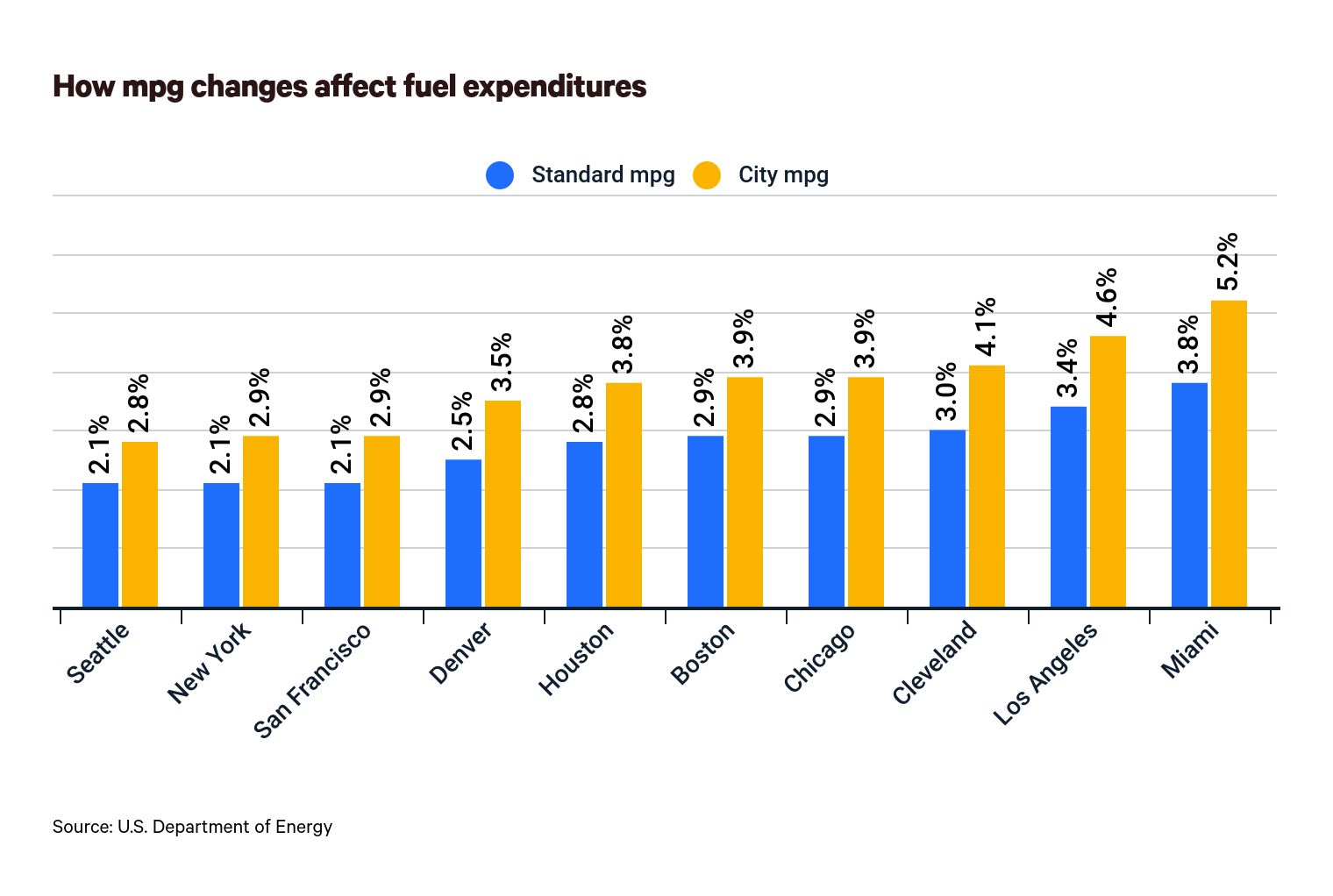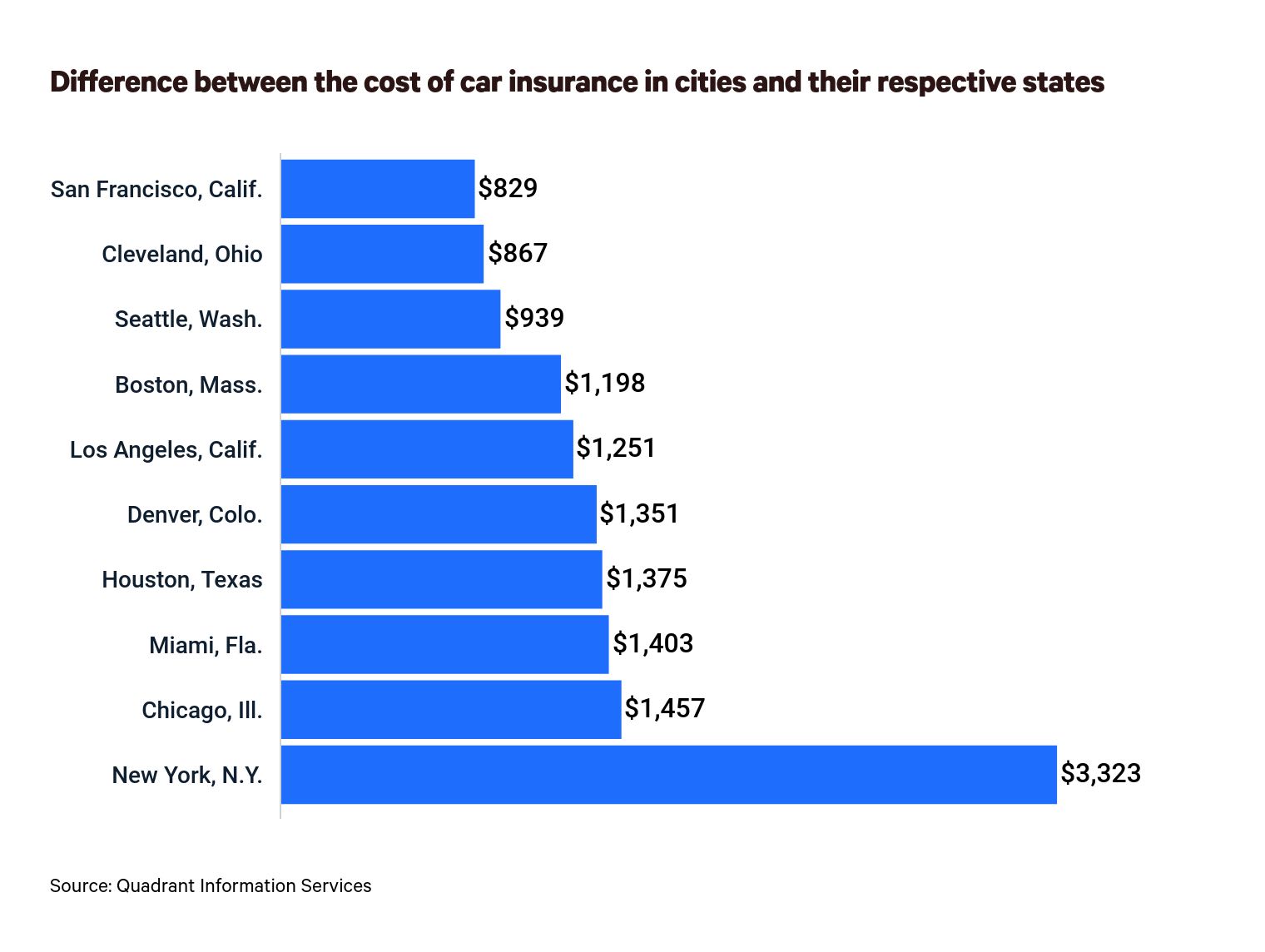Auto Insurance
Americans Spent 28% Less on Gas in 2019 Than They Did in 2010, but the Cost of Owning a Car Is Becoming Less Affordable for Some

The cost of owning a car depends on several factors that change with the driver's location. According to an analysis of one such metric — the price of gas — most Americans spent more than a quarter less of their incomes on fuel in 2019 than in 2010.
However, owning a car can be more expensive for city dwellers than those who live outside highly populated metros. A ValuePenguin analysis of the Department of Energy's historical gasoline price data reveals that while the cost of fuel relative to income is fairly affordable for urban drivers of fuel-efficient vehicles, gas is 36% more expensive for drivers of cars with average in-city fuel consumption capabilities.
Both types of drivers — urban and noncity residents — must purchase car insurance before they can legally drive. Auto insurance is a much more expensive recurring expense than gas. Additionally, unlike gas, insurance was more expensive in 2019 than in 2010. In 13 states, increases to the cost of insurance have eclipsed the typical year-over-year wage gains.
Key findings
- Americans spent less on gas relative to their incomes in 2019 than in 2010. In 2010, Americans, on average, spent 3.7% of their annual income filling up their gas tanks, versus 2.7% in 2019 — a decrease of 28%.
- Gasoline and car insurance expenditures combine to take up 5% of Americans' earnings, on average. Depending on the state, though, these costs can account for up to 15% of the median household's income.
- The rate at which city dwellers are likely to fill up their tanks means that the amount they spend on gas can be higher than average. Due to decreased fuel efficiency in cities, the total amount spent by urban dwellers on gas relative to income can increase by 36% compared to drivers of more fuel-efficient cars.
- Americans' earnings are generally rising more quickly than insurance and gas expenses. In 13 states, however, insurance costs are going up more rapidly than the amount workers are paid.
The amount spent on gas relative to Americans' income fell by 28% from 2010 to 2019
The amount Americans spent on gas across all 50 states and the District of Columbia relative to their incomes decreased from 3.7% in 2010 to 2.7% in 2019, despite increases in 2017 and 2018. Even with year-over-year increases at times, no state saw an overall increase in gas expenditures between 2010 and 2019.

Nearly half of the U.S. states saw overall gas expenditures fall by 30% or more compared to 2010. The amount spent on gas in the District of Columbia dropped the most from 2010 to 2019 — 37% relative to the median income there. Drivers in Alaska, home to the smallest relative decrease, still put 5% less of their earnings toward gas by the end of the decade.
During these 10 years, West Virginians paid the largest percentage of their incomes toward gasoline. On average, drivers in this state devoted 4.7% of their incomes to filling up their tanks.
State | Percentage of income in 2010 | Percentage of income in 2019 | Change | Average percentage of income (2010-19) |
|---|---|---|---|---|
| District of Columbia | 3.1% | 1.9% | -37% | 2.8% |
| Texas | 3.5% | 2.3% | -33% | 3.3% |
| Florida | 3.9% | 2.6% | -33% | 3.7% |
| South Carolina | 4.0% | 2.7% | -33% | 3.8% |
| Minnesota | 3.3% | 2.2% | -33% | 3.0% |
| Georgia | 3.6% | 2.4% | -33% | 3.4% |
| North Carolina | 4.1% | 2.8% | -32% | 3.9% |
| Tennessee | 4.2% | 2.8% | -32% | 3.9% |
| Rhode Island | 3.5% | 2.4% | -32% | 3.4% |
| Alabama | 4.2% | 2.9% | -32% | 4.0% |
| Arkansas | 4.5% | 3.1% | -32% | 4.2% |
| New York | 3.4% | 2.3% | -32% | 3.2% |
States are ordered by greatest change in the cost of gas relative to income, 2010 to 2019.
Poor fuel efficiency causes gas expenses to rise substantially for the typical city dweller — they can be 36% more than for drivers with better fuel efficiency
The Department of Energy tracks historical gas prices for 10 American cities. An analysis of this data shows that since there's a gap between average city and highway fuel efficiency, city drivers are more likely to burn through gas than other drivers. Consequently, they have to fill up their tanks more often. Because of this, it's more expensive to own a car and live in an urban area.
The difference between average highway and city mpg means city residents filled up their vehicles an average of 36% more frequently than nonurban drivers from 2010 to 2019 — though the number varies by year as fuel efficiency ratings change. Assuming that a standard driver fills up 52 times a year, that would mean non-fuel-efficient drivers fill up 70 to 72 times, depending on the year.

Under these conditions, it's more expensive to own a car — based on gas costs alone — in a city. Of the cities in the Department of Energy's historical records, Boston and Miami are the cities where drivers with less fuel efficiency see the highest increases among city residents. These drivers pay 42% and 41% more a year relative to their incomes than typical Massachusetts and Florida drivers who fill up their gas tanks once a week. Los Angeles drivers see cost disparities that are 35% greater compared to their counterparts in other parts of California.
After accounting for decreased fuel efficiency, the most expensive city is Boston. There, the amount spent on gas relative to one's income increases from an average of 2.8% (statewide in Massachusetts) to 3.9% (in Boston). Because of high wages, people in New York, San Francisco and Seattle pay less of their incomes, even with decreased fuel economy, than other drivers throughout the state who fill up less.
City | Average | State | Average | Difference |
|---|---|---|---|---|
| Boston | 3.9% | Massachusetts | 2.8% | 42% |
| Chicago | 3.9% | Illinois | 3.2% | 22% |
| Cleveland | 4.1% | Ohio | 3.8% | 8% |
| Denver | 3.5% | Colorado | 3.0% | 15% |
| Houston | 3.8% | Texas | 3.3% | 15% |
| Los Angeles | 4.6% | California | 3.4% | 35% |
| Miami | 5.2% | Florida | 3.7% | 41% |
| New York | 2.9% | New York | 3.2% | -10% |
| San Francisco | 2.9% | California | 3.4% | -15% |
| Seattle | 2.8% | Washington | 3.3% | -15% |
Cities sorted alphabetically.
On average, the cost of gas and insurance coverage combine to take up 5% of the typical driver's annual income
Gas isn't the only recurring cost that drivers have to expect when budgeting expenses. The cost of car insurance is a mandatory repeated payment for most drivers. On average across the 50 states and the District of Columbia, the cost of insurance equals 3% of the median annual income. It combines with the cost of gas and amounts to 5% of the median household income.

The state with the most expensive combined cost of auto insurance and gas is Michigan, where the insurance premiums are the highest in the nation. Michigan's median income is relatively modest (33rd of 51 jurisdictions), but the high cost of car insurance takes up 12% of the state's median household income. Adding gas costs, the amount Michiganders spend on owning a car equals 15% of their incomes.
State | Insurance cost | Cost of gas | Insurance expenses | Total expenses |
|---|---|---|---|---|
| Michigan | $7,406 | $1,593 | 12% | 15% |
| Louisiana | $2,337 | $1,504 | 5% | 8% |
| Kentucky | $2,228 | $1,631 | 4% | 7% |
| Florida | $2,795 | $1,534 | 5% | 7% |
| Arizona | $2,152 | $1,978 | 3% | 7% |
| Nevada | $2,047 | $2,059 | 3% | 6% |
| Mississippi | $1,451 | $1,500 | 3% | 6% |
| West Virginia | $1,367 | $1,676 | 3% | 6% |
| Rhode Island | $2,482 | $1,716 | 3% | 6% |
| Arkansas | $1,310 | $1,513 | 3% | 6% |
| Oklahoma | $1,536 | $1,560 | 3% | 6% |
| Oregon | $1,691 | $2,112 | 3% | 6% |
States are ordered by the total expenses for drivers, relative to their incomes.
The cheapest place for recurring car-related expenses is Virginia. The median household income in 2019 was in the top 25% of states in the country at $76,456 a year. This combines with a low average cost of insurance — which is in the bottom quarter of the states in terms of the average cost of coverage. Together, gas and car insurance expenses consume a 4% share of the median household income in Virginia.
Where is it getting more expensive to own a car?
The good news for consumers is that the falling price of gas in the last five years has resulted in a corresponding fall in the cost passed along to the consumer. At the same time, insurance rates have not typically fallen. The pandemic resulted in average insurance rates across the country falling in 2020. However, rates had largely increased before that point. In most states, increases to the cost of insurance have not outpaced wage growth — but not in all states.
On average, the cost of car insurance has increased more quickly than wages in 13 states.
In no state has the cost of insurance increased by a higher percentage than wages than in Nevada. Here, the average year-over-year insurance rate change was 6.9% from 2015 to 2019, while wages grew by 4.3% during this time — a difference of 2.6 percentage points. In Louisiana, Colorado and Georgia, the difference in the rate at which wages increased compared to insurance was greater than 1 percentage point.
Rank | State | Percentage point difference | Wages | Insurance |
|---|---|---|---|---|
| 1 | Nevada | 2.6 | 4.3% | 6.9% |
| 2 | Louisiana | 2.3 | 3.0% | 5.3% |
| 3 | Colorado | 1.6 | 5.6% | 7.2% |
| 4 | Georgia | 1.6 | 5.3% | 6.9% |
| 5 | Indiana | 0.6 | 3.9% | 4.5% |
| 6 | Utah | 0.6 | 4.9% | 5.4% |
| 7 | New Mexico | 0.5 | 3.5% | 4.0% |
| 8 | Maryland | 0.5 | 3.7% | 4.2% |
| 9 | Florida | 0.4 | 5.2% | 5.6% |
| 10 | Missouri | 0.4 | 4.1% | 4.5% |
| 11 | Alaska | 0.3 | 0.9% | 1.3% |
| 12 | Texas | 0.1 | 4.4% | 4.5% |
States are ordered according to the difference between insurance rate increases and wage increases.
On the other hand, it became more affordable to own a car in West Virginia. From 2015 to 2019, wages increased by 3.5% and insurance rates decreased, on average. This means that the rate at which households earned more was 3.8 percentage points greater than the increase in insurance costs.
Drivers can mitigate the higher-than-average rates that are part of owning a car in a city by . It's important to compare more than the cost of auto insurance across different companies. Drivers should also be mindful of the different discount opportunities offered by each provider before purchasing or renewing coverage.
Methodology
This study combines several data sources. ValuePenguin calculated the historical cost of gas across the U.S. using the Department of Energy's State Energy Data System (SEDS). Statewide data goes back to 1970.
The Department of Energy also tracks 10 cities' historical gas prices, which we used to compare the amount spent on gas at the city and state levels. The cities for which the Department of Energy tracks historical gas prices are:
- Boston
- Chicago
- Cleveland
- Denver
- Houston
- Los Angeles
- Miami
- New York
- San Francisco
- Seattle
ValuePenguin researchers collected income data at the county and state levels using the U.S. Census Bureau American Community Survey (one-year estimates) from 2010 to 2019 — the most recent year available. Wage data reflects the following counties, which house the cities previously mentioned:
- Suffolk County, Mass.
- Cook County, Ill.
- Cuyahoga County, Ohio
- Denver County, Colo.
- Harris County, Texas
- Los Angeles County, Calif.
- Miami-Dade County, Fla.
- New York County, N.Y.
- San Francisco County, Calif.
- King County, Wash.
ValuePenguin sourced its fuel efficiency information from the Environmental Protection Agency's (EPA) automotive trends data set. The data reflects the change in average fuel efficiency for all cars from 2010 to 2019. To estimate the cost of gas relative to a driver's income, researchers assumed that a standard driver fills up a 12-gallon tank once a week, or 52 times a year. For city drivers with lower fuel efficiency, ValuePenguin calculated the cost of gas for an average of 70 fill-ups a year, based on the yearly variability of fuel efficiency rates from 2010 to 2019.
ValuePenguin's analysis used insurance rate data from Quadrant Information Services. These rates were publicly sourced from insurer filings and should be used for comparative purposes only, as your quotes may be different.
